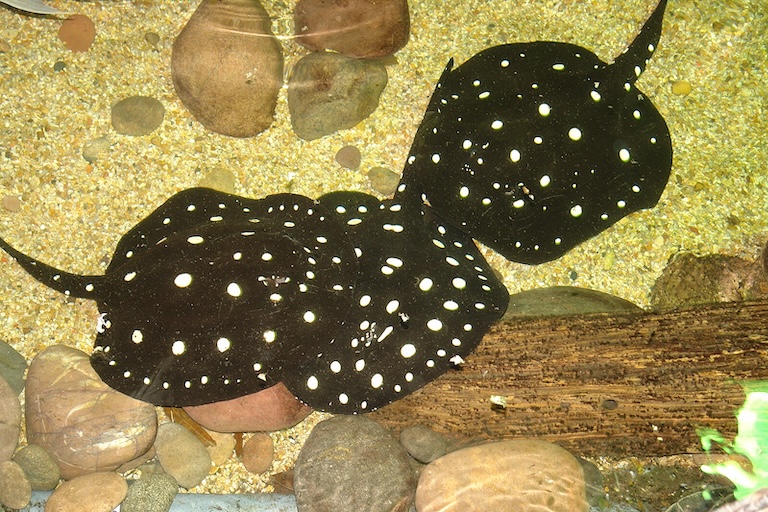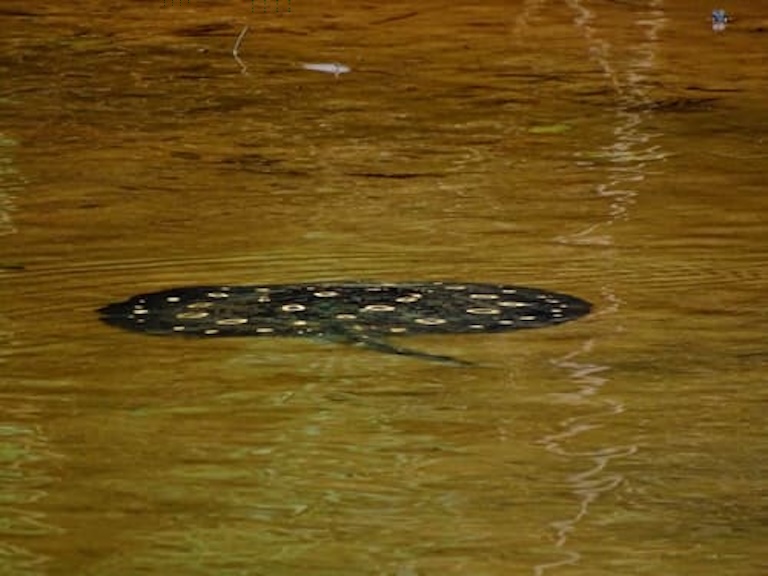Xingu River Ray Profile
Stingray was once widely known as a 1960s marionette TV show. Then, it was the maine creature responsible for the freak accident that ended the reign of Steve Irwin. But somewhat lesser known are the various freshwater stingrays found in both the New and Old-World river systems.
Lesser known to modern city dwellers, at least! Prehistoric peoples had been using their stings for thoudsands of years.
Today’s entry, named after the successor to one of the worst humans of all time, Potamotrygon leopoldi, is a very pretty example that’s gaining popularity among collectors.

Xingu River Ray Facts Overview
| Habitat: | Freshwater river systems |
| Location: | Xingu River, Brazil |
| Lifespan: | Possibly up to 28 years |
| Size: | Up to 75 cm (30 in) long, 40 cm (16 in) wide |
| Weight: | Up to 20 kg (44 lb) |
| Colour: | Dark brown/black with creamy white spots |
| Diet: | Invertebrates |
| Predators: | Other rays, catfishes |
| Top Speed: | Not reported |
| No. of Species: | 1 |
| Conservation Status: | Vulnerable (IUCN) |
Xingu River Rays are a pretty and very circular species of freshwater Stingray, endemic to the Xingu River in Brazil.
They’re popular in the aquarium trade, to the point of over-exploitation, and are currently suffering the same fate as many freshwater species in the region on account of the pollution of their waterways.
They are venomous, but not aggressive, and their presence in the rivers is important as a mid-tier predator, providing upward and downward selective pressure on their communities.
Interesting Xingu River Ray Facts
1. They’re Myliobatiformes
Rays have some of the most alien and fun-named taxonomic rankings you can find. They’re cartilaginous fishes, like sharks, so they’re in the Class of Chondrichthyes. This has two subclasses: Holocephali and Elasmobranchii, which splits the chimeras from the sharks and rays, respectively.
There are 8 or so orders of sharks, and around 4 extant orders of rays, but far more species of the latter, at around 600. The best known are the Myliobatiformes, which contains most of the famous rays like stingrays and giant mantas.
In fact, the Xingu River ray is a sting ray, in another mouthful of a taxonomic ranking: the family Potamotrygonidae. This family makes up the South American freshwater Stingrays, (as opposed to the Dasyatidae family that’s populated by the Old-World freshwater stingrays), and they inhabit tropical and subtropical rivers.
They’re also very round! And mostly very spotty, and the Xingu River ray fits both of these categories.
And, like the most infamous of stingrays – and all Myliobatiformes except the Mobula rays – they have potentially dangerous barbs at the end of their tails. This one is venomous, though if we define

2. They’re venomous
Freshwater stingrays, including the Xingu and its close relatives, are some of the most frequent causes of injuries from aquatic animals in South America.
They’re also under-reported, since the majority occur in very remote areas and are treated locally with herbal remedies, so don’t get formally recorded.
Stingray wounds predominately show up in fishermen (who are most definitely asking for it) and bathers (who generally aren’t).
However, injuries from these animals aren’t taken all that seriously, on account of the very low lethality. Still, wounds can be very painful, bring nausea and headaches, and cause potentially dangerous secondary infections.
Stingrays in general are not remotely aggressive, but they have a habit of sitting hidden in the sand an mud, so can be stepped on. The vast majority of injuries occur in the lower limbs. 1
3. They change as they age
Juvenile animals have different priorities than older ones, often relating to factors such as the threat of predation and the relative size of the foods they eat.
Young Xingu rays have a much stronger venom than their elders, which helps keep them safe from being eaten, and conversely, they have much softer mouths, which take time to harden as they age. Softer food, then, is on the menu for the babies, while the adults can venture into the larger, hard-shelled variety as they grow.2
4. They may have been used as spears
Here is a bit of speculation in relation to this particular species, since there doesn’t seem to be any evidence of the Xingu ray being used for this purpose, but all over the world, animals just like it have been, so it’s not too far-fetched to make the assumption.
The stingray barb is incredibly hard, especially considering it’s made of cartilage, and being a sharp, barbed point designed for piercing and cutting, it has not gone unnoticed among the various tribes of prehistoric people who used it to tip spear points to poke each other with. 3
It’s also been used for hunting megafauna, for sure as close as Central and North America, and therefore probably well into Brazil too. And in Mayan culture, stingray barbs have been confirmed as a method of ritual bloodletting.
5. They’re in trouble
Being such a pretty fish, and a freshwater one to boot, makes this a popular specimen for larger aquariums, and the international aquarium trade has inspired a spike in catches for this purpose. International markets for its meat are also on the rise for the same reason, and locally, it’s not a popular catch because of the danger of its sting, so while it might be thrown back in, often it’s killed first or has its tail cut off.
Development of dams and other infrastructure have disturbed its range, too, and the increase in mining has another huge effect on the quality of its water. Grazing of livestock, similarly, presents increased runoff contamination and climate change, the great equaliser, is of course adding its pressure to the freshwater systems in the area, as it is everywhere.
So, this pretty little ray is in decline and has jumped onto the IUCN’s Red List from being Data Deficient in 2009 to straight up vulnerable in 2022. This is primarily based off a 45% decline in catches between 2005 and 2021 in the ornamental trade hotspots. 4
Xingu River Ray Fact-File Summary
Scientific Classification
| Kingdom: | Animalia |
| Phylum: | Chordata |
| Class: | Chondrichthyes |
| Order: | Myliobatiformes |
| Family: | Potamotrygonidae |
| Genus: | Potamotrygon |
| Species Name: | leopoldi |
Fact Sources & References
- da Silva et al. (2020), “Injuries Caused by Freshwater Stingrays in the Western Amazon: Folk Medicine and Beliefs”, Ethnobiology Letters.
- Kirchhoff (2014), “Maturity-related changes in venom toxicity of the freshwater stingray Potamotrygon leopoldi”, ScienceDirect.
- Schulting et al.(2022), “A sting in the tail: An embedded stingray spine in a mid-1st millennium AD adult male skeleton from Rebun Island, Hokkaido, Japan”, ScienceDirect.
- (2022), “Xingu Freshwater Stingray”, IUCNREDLIST.
